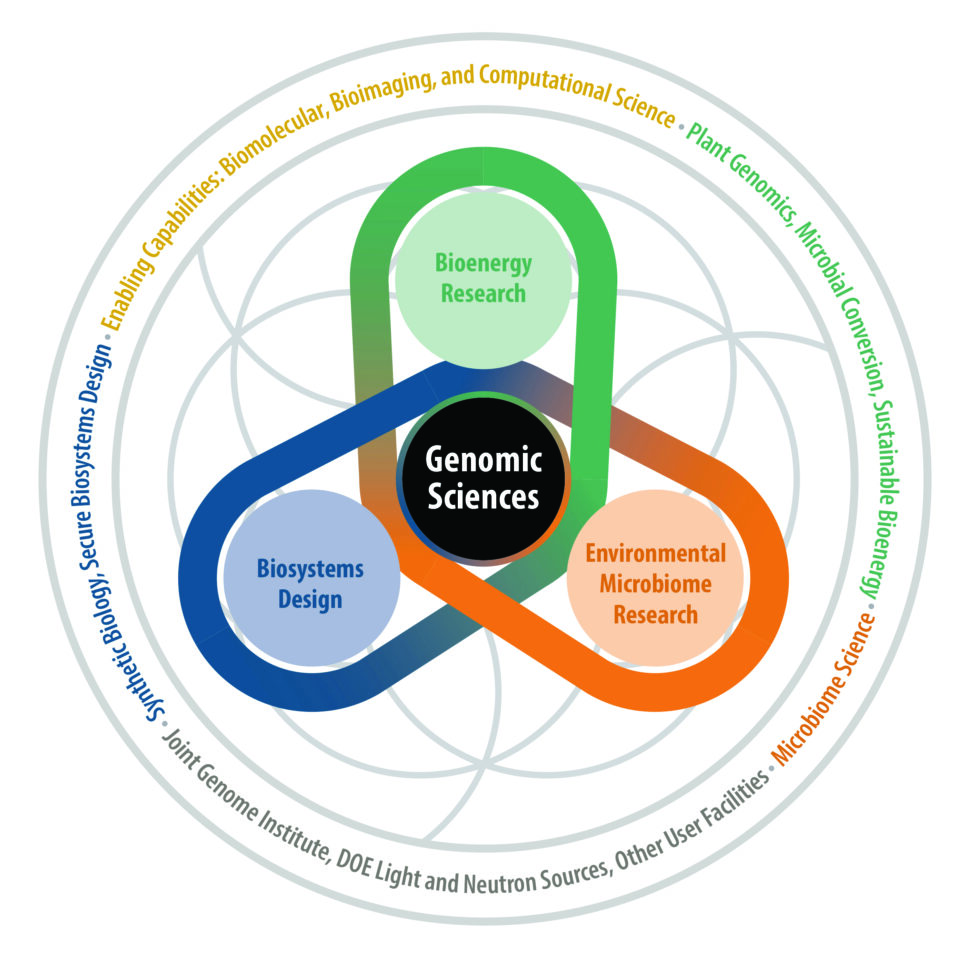About the Program

BER’s Biological Systems Science Division Multidisciplinary Portfolio. Broadly grouped under Bioenergy Research, Biosystems Design, and Environmental Microbiome Research areas, the program pursues innovative science underpinning advances in sustainable biofuels and bioproducts; the design, modification, and optimization of plants and microbes for beneficial purposes; and next-generation technologies for systems biology research.
The Genomic Science Program’s (GSP) overall research goal is to provide the necessary fundamental science to understand, predict, manipulate, and design biological systems that underpin innovations for bioenergy and bioproduct production and to enhance our understanding of natural, DOE-relevant environmental processes. GSP is part of the Biological Systems Science Division (BSSD) within the U.S. Department of Energy’s Biological and Environmental Research (BER) Program.
BER has been at the forefront of genome biology research since its pioneering role in initiating the sequencing of the human genome. This effort was a milestone in genome biology that spurred an accelerating revolution in genome sequencing technology and other omics techniques that fuel today’s biotechnology innovations. More recently, genomic science advances have stemmed from insights gained through the increasingly multidisciplinary collaborations of biologists, chemists, physicists, computer scientists, and engineers.
The program supports basic research to answer fundamental biological questions including:
- What information is encoded in a genome sequence, and how does this information direct the functional characteristics of cells, organisms, and whole biological systems?
- How do interactions among cells regulate the functional behavior of living systems, and how can these interactions be understood dynamically and predictively?
- How do plants, microbes, and communities of organisms adapt and respond to changing environmental conditions (e.g., temperature, water and nutrient availability, and ecological interactions), and how can their behavior be manipulated toward desired outcomes?
- What organizing biological principles need to be understood to facilitate the design and engineering of new biological systems for beneficial purposes?
Research Areas
More defined research areas include bioenergy research, genome biology and sustainability of bioenergy crops, biosystems design or synthetic biology, environmental microbiomes, and computational biology and cyberinfrastructure for genomic science. These areas represent distinct pillars of the program, but each one is also tightly integrated with other portfolio elements, such as enabling capabilities and user facilities, through targeted, crosscutting funding opportunities and DOE national laboratory projects. Among these intersecting themes are three major components: Bioenergy Research, Biosystems Design, and Environmental Microbiome Research.
Bioenergy Research seeks to couple a basic understanding of plants and their associated microbial communities to advance the sustainable production of biofuels and bioproducts from plant biomass. Dedicated crops grown on marginal lands for conversion into renewable sources of fuels or valuable chemicals and bioproducts represent a key strategy to reduce the nation’s reliance on fossil resources for the production of these critical materials. Because fossil resources are ultimately finite and subject to economic and geopolitical uncertainty, renewable sources for the fuels and products that support modern society are of keen interest to DOE, and they are a long-term strategic need for the nation and a strong bioeconomy.
Biosystems Design efforts focus on understanding fundamental biological principles to enable the design and engineering of plants and microbes with new or enhanced traits beneficial for energy or environmental applications. Rapid advances in genome-enabled discovery, design, and engineering are leading to exciting new possibilities in biotechnology to create new biosynthetic processes by drawing from the gene diversity found in nature and accumulated understanding of biological processes. This area of research is both fascinating in terms of its possibilities and challenging as the global pace of research is accelerating rapidly. BER is committed to building on its established presence in the field of basic genome-enabled research and using newfound knowledge to explore possibilities in genome design.
Environmental Microbiome Research seeks to understand how microbes and plants interact in their natural environment. Microorganisms and plants have evolved in the context of complex microbiomes and environmental change. Discovering how microbes interact within communities and adapt to environmental perturbations and long-term change is essential for understanding the many bioenergy and environmental processes relevant to DOE. Of particular interest is the ability to predict interactions among organisms based on the information encoded in their genomes, as well as the dynamic expression of their activities in association with one another and their environment. Gaining a predictive and functional understanding of microbiomes will enable better understanding of microbial ecology, plant-microbe interactions, and the cycling of elements in terrestrial environments.
Enabling Capabilities
Computational Biology and Cyberinfrastructure seeks to create open-access and integrated computational capabilities tailored to large-scale data science investigations for molecular, structural, genomic, and omics-enabled research on plants and microorganisms for a range of DOE mission goals.
DOE Joint Genome Institute is GSP’s flagship user facility, providing genomic science user support for bioenergy research and other DOE mission-relevant topics such as biosystems design and environmental systems biology. Capabilities including genomic sequencing, DNA synthesis, and metabolomics are made available through regular community proposal solicitations and joint funding with the Environmental Molecular Sciences Laboratory via the FICUS program.
Complementary BER Research
Bioimaging Science Program develops new imaging and measurement technologies to visualize the spatial and temporal relationships of key metabolic processes governing phenotypic expression in plants and microbes.
Structural Biology and Cryo-EM Imaging Resources are BER-funded unique, best-in-class capabilities within Office of Science user facilities (including JGI, EMSL, and DOE’s light and neutron sources) to enhance multidisciplinary Bioenergy Research, Biosystems Design, and Environmental Microbiome Research.
